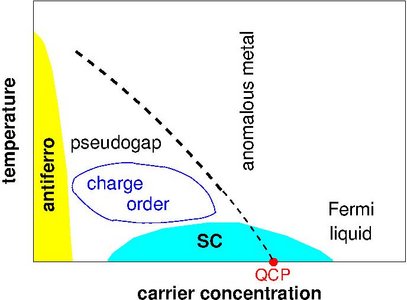Schwerpunkte
Halbleitertheorie
Research profile of the nanoelectronics group
In our nanoelectronics group we consider nano-scale transistor systems which can be either semiconductor based or molecular junctions. In the former case we study conventional field effect transistors, modern multigate transistors or SOI (silicon on insulator) transistors. Within the last decade we have established a comprehensive software package to analyze experimental devices in the frame of the Landauer-Büttiker formalism. As a particular focus we have long standing cooperation analyzing device data by GLOBALFOUNDRIES Dresden.
Supraleitung und elektronische Korrelationen
Superconductivity and electronic correlations:
Superconductors were discovered in 1911 by Heike Kamerlingh Onnes and are materials which can transport electrical current without any electrical resistance below some critical temperature Tc. Besides they also expell a magnetic field from their interior and thus can be viewed as 'ideal' diamagnets (Meissner-Ochsenfeld effect). Both properties make superconductors suitable for a large variety of interesting applications, ranging from dissipationless transport in electricity networks to magnetic levitation for high-speed trains.
Conventional superconductors (e.g. Pb or Nb alloys) have transition temperatures up to approx. 20 K so that only cooling with liquid helium can establish the superconducting properties. In 1986 Bednorz and Müller discovered the so-called high-temperature superconductors with transition temperatures up to approx. 130 K so that these materials become superconducting already at the temperature of liquid nitrogen.
High-Tc materials are a challenge in solid-state physics, not only because the mechanism leading to high transition temperatures is still unknown, but also because of their unusual and so far unexplained metallic properties. Common structural elements of these materials are the copper-oxygen planes which are mainly responsible for the electronic properties. They are characterised by a generic phase diagram (see Fig. 1) where as a function of doping an antiferromagnetic (AF) Mott insulator evolves into a superconductor with highly unconventional metallic behaviour in the normal state above T. First of all around optimal doping (where Tc is highest) non-Fermi liquid features arise (most notably exemplified by a resistivity which is linear in T up to high temperatures). Only at larger dopings a seemingly Fermi liquid behavior is recovered. On the other hand, at low-to-moderate dopings a pseudogap opens below a crossover temperature T*.

The pseudogap correlations suppress spectral weight, strongly reduce the entropy and magnetic susceptibility. Angle-resolved photoemission and tunneling experiments have revealed that upon cooling the pseudogap merges into the superconducting (SC) gap implicating a close relation between both phenomena.
As a function of charge carrier concentration both gaps merge at about optimal doping where the above noted unconventional metallic behaviour is most pronounced. In addition an increasing number of experiments provides strong evidence that the pairing mechanism may be related to the susceptibility of high-Tc cuprates towards the formation of electronic charge (and spin) inhomogeneitites forming ordered textures. These have been first observed in lanthanum cuprates in the form of stripes within neutron scattering and more recently by resonant x-ray scattering experiments. Furthermore resistivity measurements under conditions where superconductivity has been suppressed by strong magnetic fields have revealed an underlying metal-insulator transition close to optimal doping suggestive of a so-called quantum critical point (QCP) (see Fig. 1) due to the formation of incommensurate charge ordering CO (like, e.g. an incommensurate charge-density wave).
From the above one can extract two main features of these materials: they are prototypical strongly correlated systems and they have a complex phase diagram, where various phases compete (AF, CO, SC, ...).
Our research aims to tackle these aspects by studying the properties of inhomogeneoeus electronic phases on the basis of appropriate correlated multi-band models. Formally, many of our calculations are carried out within the so-called time-dependent Gutzwiller approach which allows to study the dynamical response of a strongly correlated electron system to external perturbations so that results can be compared with a large variety of experimental probes.
